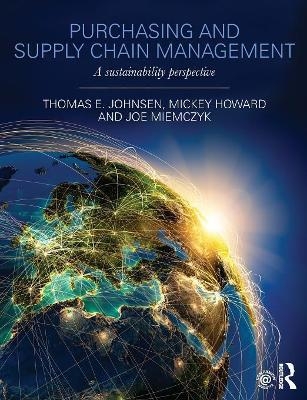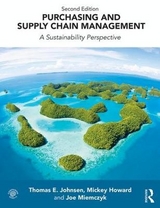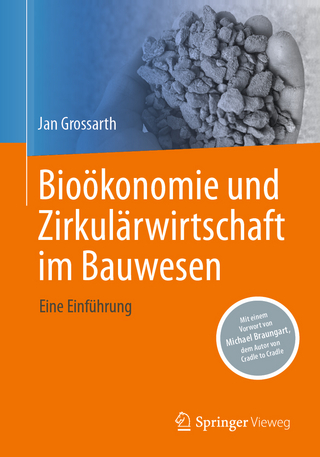
Purchasing and Supply Chain Management
Routledge (Verlag)
978-0-415-69088-1 (ISBN)
- Titel erscheint in neuer Auflage
- Artikel merken
Aimed at students, educators and practitioners the book integrates sustainability into each chapter as a core element of purchasing and supply chain management. Incorporating case studies from industry into each chapter, the book strikes a balance between theoretical frameworks and guidelines for implementation in practice.
Thomas E. Johnsen is Professor of Purchasing and Supply Management at Audencia Nantes School of Management, France. He is currently also Part-Time/Visiting Professor of Supply Chain Management at the University of Southern Denmark and serves as Associate Editor of the Journal of Purchasing and Supply Management. Mickey Howard is Associate Professor in Purchasing and Supply Chain Management at the University of Exeter Business School. His research investigates the implementation of supply strategy including service innovation, complex performance and sustainability. He is the co-author of Procuring Complex Performance: studies of product-service innovation, Routledge, NY. Joe Miemczyk is Associate Professor of Operations and Supply Chain Management, and Academic Director of the Masters in Supply Chain and Purchasing Management at Audencia Nantes School of Management, France. He is a member of CRET-LOG (Centre de REcherche sur le Transport et la LOGistique), Aix Marseille Univeristé. He worked in industry implementing Environmental Management Systems. He has published on sustainability and supply chains for more than 10 years.
1. Introduction to Purchasing and Supply Management: A Sustainability Perspective Part I: Purchasing and Sourcing 2. Purchasing Management 3. Supplier Relationship Management 4. Sourcing and Outsourcing 5. Purchasing and Innovation Part II: Supply Chain and Network Management 6. Supply Network Design 7. Production and Operations 8. Logistics Decisions in the Supply Network 9. Distribution Systems Part III: Policy, Tools and Implementation 10. Supply Chain Mapping and Evaluation 11. Legislation, Standards and Codes of Conduct 12. Managing the Sustainable Supply Chain 13. Conclusion
Chapter 1 Introduction
Tracks the emergence of purchasing as an academic discipline and explains why it should be seen as a strategic business function. We explain why and how purchasing is now an essential part of supply chain management and the criticality of a sustainability perspective. Key concepts are defined and the underpinning theoretical framework of the book is explained. The chapter concludes with an overview of the book.
Chapter 2 The strategic sourcing and purchasing process
Begins by providing a framework for the strategic sourcing process and explains how the purchasing process needs to be understood as part of the wider and more strategic process. The different stages of the purchasing process are then explained including how sustainability needs to be addressed at each of these. The chapter addresses the stages of specifying, selecting, contracting, ordering and expediting, and evaluating.
Chapter 3 Purchasing strategy and organization
Discusses the meaning and importance of purchasing strategy and strategic purchasing and provides guidance on how purchasing maturity models can be used to evaluate how strategic the purchasing function is within a company. We discuss the importance of considering different purchase categories and explain the different ways of organising purchasing, exploring how purchasing and sustainability functions can be integrated. The chapter evaluates the skills and competencies required of purchasing managers and explores how development of sustainable purchasing and supply management may require new skills and competences. Finally, the chapter considers the special case of public procurement and explores how public procurement can be used as a lever for sustainable development.
Chapter 4 Sourcing strategy and supplier relationship management
Begins by evaluating different structural sourcing options, in particular the trend from multiple-sourcing towards single/partnership sourcing. We explore why a reversed trend back to multi-sourcing may be taking place, before examining how sourcing portfolio models can be used to guide the sourcing strategy decision. Chapter 4 also takes a close look at theoretical models of customer-supplier relationships and discusses the importance of established methods of supplier assessment and development and how these practices apply in practice when evaluating supplier sustainability. The chapter concludes with an evaluation of methods for supplier relationship assessment and management.
Chapter 5 Outsourcing and Global Sourcing
The first part of the chapter focuses on outsourcing and examines outsourcing decision models by evaluating the so-called `make-or-buy’ decision. In order to understand these we evaluate and compare some well-known theoretical perspectives, including the Resource-based View and Transaction Cost Economics. The second part of the chapter focuses on the challenges of outsourcing to, and sourcing from, global supply markets, especially Low Cost Countries (LCCs) such as China which have emerged as major supply markets due to significant cost advantages. New terminology has emerged that questions the idea of outsourcing such as local supply or `localism’, hinting at the difficulties of monitoring and controlling complex global supply networks and the advantages of more sustainable models of sourcing from markets nearer to home.
6 Purchasing, Innovation and Technology
Explains the link between purchasing and different forms of innovation. The first part of the chapter revolves around the concept and models of Early Supplier Involvement (ESI) in new product development (NPD); we explain the reasons for, and significance of, early supplier involvement. We identify ESI success factors and a model for managing ESI. We also explore the importance of supplier involvement in sustainable NPD and explore the challenging case of managing discontinuous innovation. The second part of the chapter shifts the focus from product to process innovations. We discuss how technology has progressed from electronic data interchange (EDI) towards e-procurement, e-hubs and social media and cloud computing, and how sustainability affects the different forms of e-procurement.
Chapter 7 Supply Chain Strategy
Discusses the implications of sustainability for supply chain strategy and starts by defining common terms such as supply chain and supply network. Applies lean, agile and hybrid supply chain approaches by considering the importance of product and market characteristics. The evolution from mass production to mass customization raises the prospect of a more customer-orientated and responsive supply chain strategy based on sustainable consumption. We discuss how environmental and social risks, such as tsunami, pollution or labour exploitation, require new closed-loop supply chain models and strategies that focus on transparency and traceability.
Chapter 8 Service-based Supply Chains
Introduces the concept of services to the supply chain as an important source of adding value and as a distinct yet complementary approach to production operations. It is sometimes easy to mistake the supply chain as merely an efficient mechanism for the delivery of goods and indeed many people readily associate fast-moving consumer goods with the term `supply chain’. The reality today however is that many organizations particularly in the west derive most of their revenue from complex bundles of services delivered downstream from production. Products and services must be understood as an integrated package. We discuss how this affects the management of extended lifecycles, design of product recovery systems, creation of new operating models, and how manufacturers need to engage with suppliers and customers in the future.
Chapter 9 Logistics Management
Logistics is the movement and storage of goods in the supply chain, where decisions typically centre round the balancing of transportation and inventory costs, and service levels. Transport costs are rising with the increase of fuel costs and various other mandated limits for transport, and so the balance transport and stock is changing. Yet at the same time customers are demanding faster more responsive delivery, on a global basis. This chapter examines these issues in the context of environmental imperative in particular. Examples and case studies are taken from industry practice to show how these imperatives are being integrated into today’s logistics decisions.
Chapter 10 Distribution Systems
Distribution systems impact on supply chain design and specifically focus on the consumer end of the supply chain. Many sustainability initiatives are driven by consumer concerns so it is important to understand the structures that exist to deliver products to them. Key trends in distribution such as e-commerce have revolutionized distribution in recent years, but also have significant implications for environmental performance. As consumers are typically located in urban areas, public authorities also have a role to play in the design of distribution systems. This chapter discusses these issues and highlights where there are opportunities and risks in providing sustainable distribution.
Chapter 11 Supply Chain Mapping & Evaluation
Introduces supply chain mapping and evaluation as key elements to starting the implementation process towards a sustainable supply chain. It is often only when firms attempt to put into practice what they have been talking about that the real challenges begin to emerge. It is important, therefore, to understand the links between supply strategy, external policy, enabling tools and implementation that allows the shift towards sustainability to take root. The first step in implementing a sustainable supply chain requires an in-depth understanding of the types of impact e.g. emissions, water usage, the firm seeks to target as a priority. The chapter discusses evaluative capability of tools such as supply chain mapping and lifecycle analysis. It discusses the role of policy drivers and practices which not only help firms in being more effective and resource efficient, but also actively engages them in the broader vision of sustainability.
Chapter 12 Legislation and Standards
One of the key drivers of sustainability in supply chains is the influence of policy and standards. Government, international organizations and companies are developing stringent rules at an almost exponential pace that suppliers have to comply with. This increases the complexity of dealing with environmental and social sustainability very significantly, especially where is it no longer acceptable to `blame’ your supply chain for bad practices. Therefore the supply management’s profession is seeing an expanding frontier of due diligence needs. This chapter overviews some of the main types of policy measures and shows how multi-stakeholder engagement is now the new norm for developing and implementing policy and standards in supply chains.
Chapter 13 Challenges of Sustainable Supply Chains
This chapter provides an overview of some of the most recent development in sustainability and provides a link to how these developments present a challenge to supply chains now and in the future. Although the concept of sustainability has now been in common usage for a number of decades, the underlining principles are constantly being refined and even redefined. Therefore it is important to keep abreast of these developments and to understand how supply chains are and will be affected. The chapter includes key sustainable supply chain concepts such as industrial ecology and stakeholder engagement practices.
Chapter 14 Conclusions
Highlights the different ways in which sustainability impacts purchasing and supply chain management practices. Following a brief summary of key points, we set out what we see as key sustainability challenges for purchasing and supply chain management. We conclude the book by reflecting on recent developments in higher education towards sustainable, or responsible, management in general and, more specifically, purchasing and supply chain management education.
| Zusatzinfo | 85 Line drawings, black and white; 3 Halftones, black and white; 33 Tables, black and white; 88 Illustrations, black and white |
|---|---|
| Verlagsort | London |
| Sprache | englisch |
| Maße | 189 x 246 mm |
| Gewicht | 848 g |
| Themenwelt | Naturwissenschaften ► Biologie ► Ökologie / Naturschutz |
| Wirtschaft ► Betriebswirtschaft / Management ► Logistik / Produktion | |
| Wirtschaft ► Betriebswirtschaft / Management ► Marketing / Vertrieb | |
| Wirtschaft ► Betriebswirtschaft / Management ► Unternehmensführung / Management | |
| ISBN-10 | 0-415-69088-9 / 0415690889 |
| ISBN-13 | 978-0-415-69088-1 / 9780415690881 |
| Zustand | Neuware |
| Haben Sie eine Frage zum Produkt? |
aus dem Bereich



